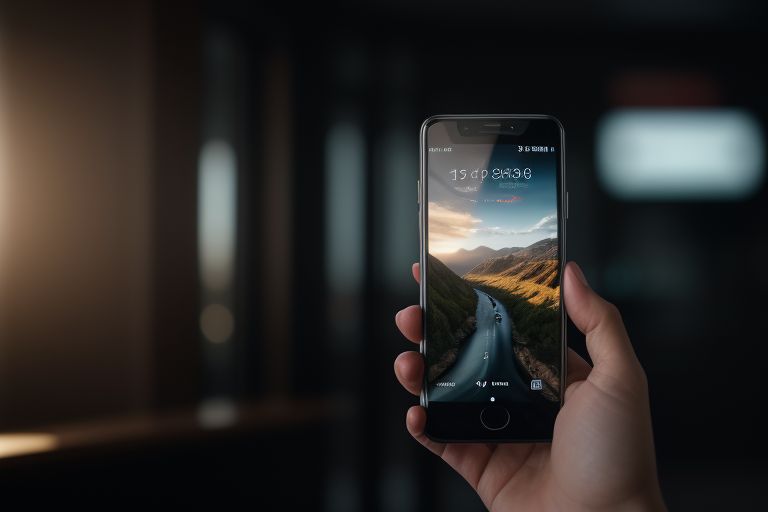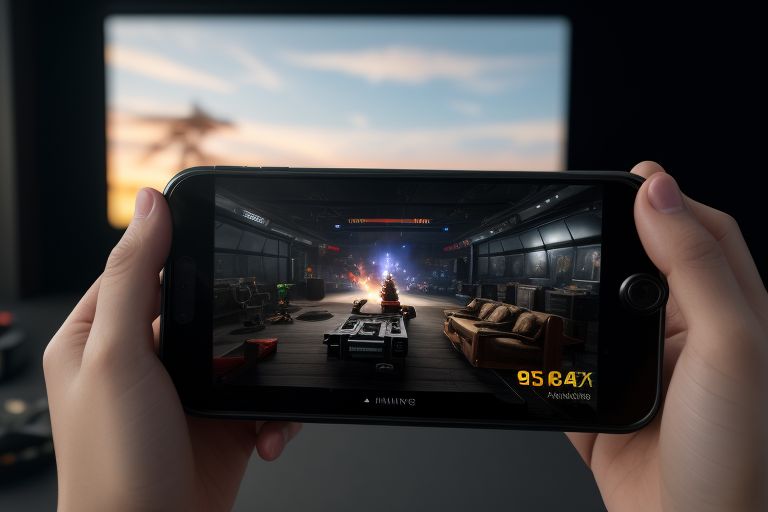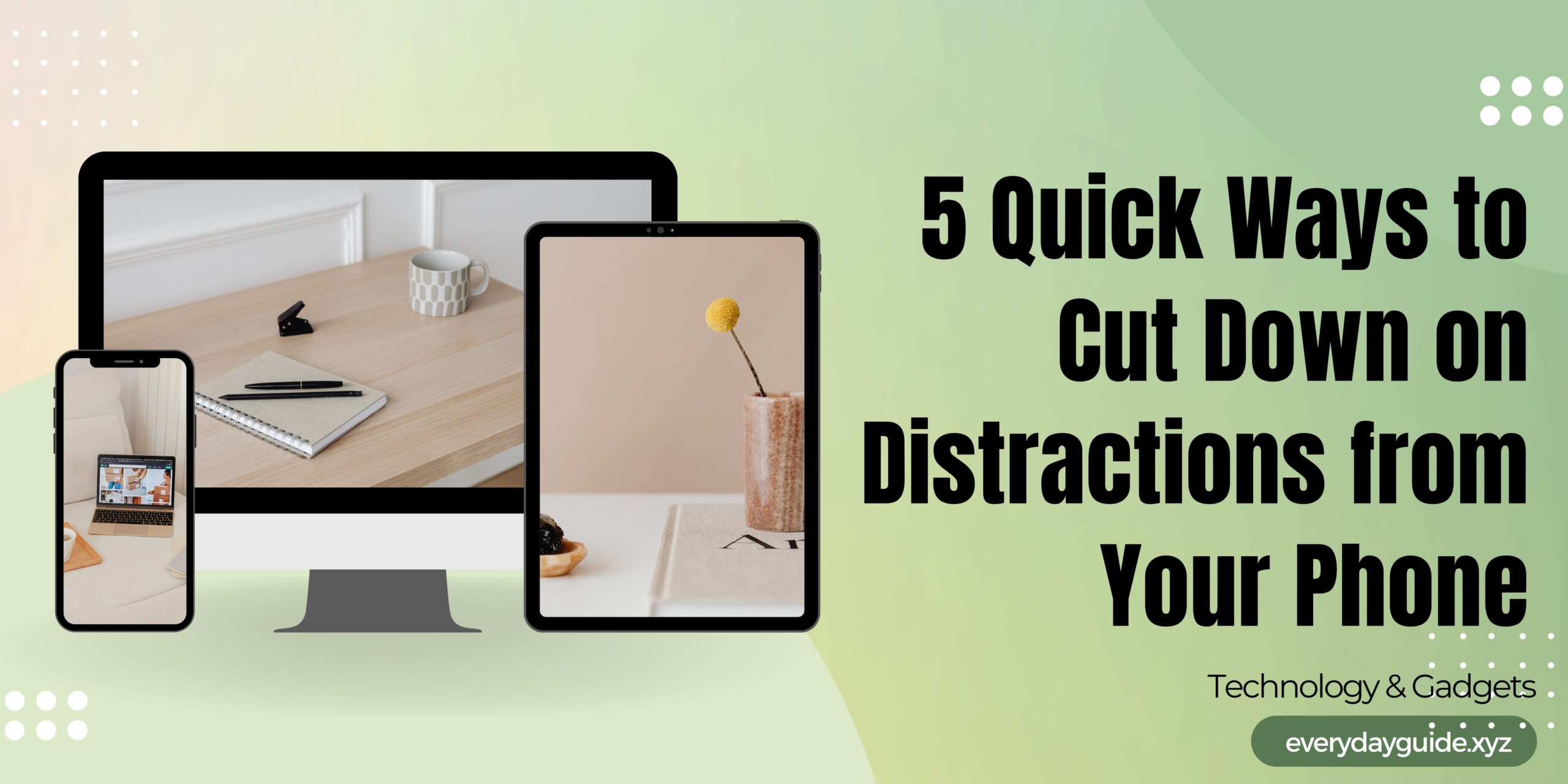Our smartphones have become both our best friends and our worst enemies in the hyperconnected world of today. Sure, they provide us with an unprecedented level of convenience and connectivity — but they also double as endless wells of distraction, pulling our attention away from the tasks that actually matter (those on which we must focus).
In this ultimate guide, we look at five quick and powerful ways to reduce distractions from your phone in order to take back control of your time and attention. Incorporated these actionable tips into your lifestyle and you have taken a solid step towards leading a more productive day, having better mental clarity and fostering a healthier relationship with both digital & real world.
Smartphone Conundrum: Juggling Between Comfort and Focus
With our fast-paced digital lifestyle today, smartphones are definitely one of the vital gadgets that have made human life so much easier. We hold a world of potential in the palm of our hand, whether it be for communication, entertainment or productivity not to forget navigating wherever that could take us. But this continuous connection does not come free. Those non-stop notifications, never-ending social media feeds, and endless looping addictive apps can reduce you to a perpetual state of distraction that can wreak havoc on your ability to focus on meaningful work and maintain human-level relationships.

Prior science shows the normal individual checks his telephone an amazing 96 times each day — every 10 minutes! This continuous break not only inhibits productivity but also leads to higher stress levels, a shorter focus and even physical problems such as neck pain or dry eyes. The problem is that when we start to be more aware of these negative consequences, you need to take action and create some different habits if you ever want to use your smartphone in a healthier way… In the next sections, I will cover 5 quick but very practical ways for getting rid of your phone distractions and taking back time, attention & well-being.
Take Back Control — Manage Notifications like a Pro
Notifications are one of the main factors that pull your attention away from your phone. Each ping, buzz, or flash of light on your device can prompt a Pavlovian r esponse to check your phone no matter what you are doing. That not only breaks your flow but is also far from the ideal state where focus needs to be diverted toward the important tasks. You want to deal with the fact that this is a strategic notification management.
Review Your Notification Ecosystem
Before you can master notification management, you should take a step back and perform an audit of your current notification settings. Great, so review every app that is on your phone and the type of notifications these apps send. Here are a few questions to ask yourself:
With which of these notifications are you really dealing with at the end of the day on a professional or private level?
What kinds of notifications should be deferred or grouped?
But doing so will give you a box to put all of your notifications into and understanding where these interruptions line up in your digital life means that you can make the decisions about which ones get kept and which ones are thrown out.
Notification System Deploying Tiers

After taking inventory of your notifications, move on to a tiered system that brings crucial information to the forefront without ensaring you with needless distractions. Here’s a suggested framework:
Tier 1 (Immediate Attention): These are high priority notifications and immediate action necessary. It can be messages from your closest family, some very important work email or maybe alerts from your banking app. Enable sounds and lock screen notifications for these useful alerts.
Notification Type: Tier 2 —Important (but not necessary right now) These include mentions on social media, work communications that are not time-sensitive or news alerts. Tapping on them eventually expands into showing your full notification center (without sound or vibration for these, of course).
Non-Essential Tier 3: These are notifications you can read whenever you have time. This could mean a game update, promotional emails or app notifications. Please turn these off or let me check them when I have time.
With this tiered system, you won’t be interrupted by anything other than what is actually important while still being informed of essential stuff going on.
Using Do Not Disturb and Focus Modes
Modern-day smartphones have powerful Do Not Disturb (DND) and Focus mode. These tools can be extremely useful for controlling the notifications and removing distractions. Below is a simple tutorial on how to make the best of them:
Enable DND Hours: Create hours of the day when it auto-turns on for focus time (work hours, study sessions, or late at night while you are asleep).
Set up DND: Most of the Do not disturb modes let you to select particular contacts or repeated callers as an exception. This is what you want to use to prevent yourself from missing any calls or messages that genuinely matter.
Use Focus Modes: A number of smartphones now include various Focus modes to help you stay focused on what you need to do —whether that be work, some personal time, or a spot of exercise. Configure these modes to automatically filter and just let notifications according to your context.
Location Based triggers: On some phones you can turn DND or focus modes on based on your location. E.g., You can have your phone trigger Work Focus mode once it detects that you’ve landed at your office.
When used together, these things will make sure only the things you really need to see are interrupting you but still ensure that your colleagues and friends can get a hold of you.
Streamlining Your Smartphone for Maximum Efficiency /Decluttering Your Digital Space
Similarly, as mess in your physical space can cause you to feel mentally cluttered and reduce your productivity, too much digital clutter on the smartphone can do exactly that. Increased clutter is overwhelming and only likely to draw you back into mindless scrolling or app flipping. Decluttering your digital world will help to ensure your smartphone provides you with a focused and efficient working environment.

Hyptothesis Doing a Digital Declutter
Ultimately, the best way to streamline your smartphone is performing a digital declutter. This includes looking at every app, file and other content in your device and deciding what to keep, re-organise or delete. A Step–by-Step Guide to Help You Through the Process
App Inventory: Look through each and every app on your phone. Ask yourself:
- How long has it been since I opened up this app?-
- Does this app create real value in my life/work?
- Is there a better app that does the same thing?
Delete Unused Apps: Get rid of apps you rarely use, or never use at all. Not only does this clean up space, it also helps with the aesthetic and will reduce any potential distractions.
Categorize Remaining Apps: Put all the similar apps in folders of a specific function or usage. You can use folders by directly placing productivity tools, social media etc.
Clean Your Photos and Files: Sort through your photo gallery and file storage, remove duplicate images, blurry shots, and any files you don’t need. How to Backup Important files To free space on device.
Purge App Caches: Apps store a lot of cache data that can clutter up your device over time. Relatively to improve & free up storage space Clear these caches.
Also Read More:
- How to Pack a Carry-On Like a Pro in 5 Simple Steps
 It has been a complete game-changer to pack less and go the carry-on route. It saves you time at the airport, and it also simplifies any trip to your destination. Have you ever wanted to learn how to pack a carry… Read more: How to Pack a Carry-On Like a Pro in 5 Simple Steps
It has been a complete game-changer to pack less and go the carry-on route. It saves you time at the airport, and it also simplifies any trip to your destination. Have you ever wanted to learn how to pack a carry… Read more: How to Pack a Carry-On Like a Pro in 5 Simple Steps - How to Keep Your Clothes Wrinkle-Free While Traveling
 As thrilling as traveling can be, the reality is that removing wrinkles from clothing while on the move remains among the popular problems travelers encounter. There is nothing worse than setting out for a busy day in a new city or… Read more: How to Keep Your Clothes Wrinkle-Free While Traveling
As thrilling as traveling can be, the reality is that removing wrinkles from clothing while on the move remains among the popular problems travelers encounter. There is nothing worse than setting out for a busy day in a new city or… Read more: How to Keep Your Clothes Wrinkle-Free While Traveling - How to Travel Cheap Without Sacrificing Fun
 One of the most enriching experiences in life happens to be traveling, but it always seems as though travel comes at a steep price. But it is possible to travel and have fun on a tight budget with some creativity and… Read more: How to Travel Cheap Without Sacrificing Fun
One of the most enriching experiences in life happens to be traveling, but it always seems as though travel comes at a steep price. But it is possible to travel and have fun on a tight budget with some creativity and… Read more: How to Travel Cheap Without Sacrificing Fun - Best Apps for Finding Cheap Flights and Hotels
 Everyone loves to travel but the sky-rocketing prices of flights can sometimes drive us to halt our wanderlust. But, fortunately in today ‘s age of fast technology this is not so tough to discover your Cheap Flights In London as well… Read more: Best Apps for Finding Cheap Flights and Hotels
Everyone loves to travel but the sky-rocketing prices of flights can sometimes drive us to halt our wanderlust. But, fortunately in today ‘s age of fast technology this is not so tough to discover your Cheap Flights In London as well… Read more: Best Apps for Finding Cheap Flights and Hotels - The Importance of Quality Time Together
 The business of life can easily overshadow what is most important… being with the people we love. Quality time strengthens relationships; it creates an emotional connection and better mental well-being. Knowing how it feels to share quality time with your family,… Read more: The Importance of Quality Time Together
The business of life can easily overshadow what is most important… being with the people we love. Quality time strengthens relationships; it creates an emotional connection and better mental well-being. Knowing how it feels to share quality time with your family,… Read more: The Importance of Quality Time Together
Creating a Minimalist Home Screen
Declutter your digital space and have a minimalist home screen that focuses on what you need. Create an organized home screen with these tips

Limit Home Screen Apps: Add to home only most frequently used apps. These are the apps that you should be using within daily routine tasks. Push less-used apps back to secondary screens/folders
Keep Things Barebones: Get an uncluttered or even blank wallpaper that does not distract the eye from your app icons Keep patterns and colors simple
The One-Page Rule: try to make all your most important apps available on one home screen page and not dwelling into any more pages. Alternatively, this will force you to prioritize and eliminate tons of pointless browsing.
Use Widgets: Utilize widgets (if your phone has them) wisely to see information available at a glance without having to launch apps. For instance, a calendar widget can display your upcoming events without needing to open the app every time.
Negative Space Embrace Negative Space — No need to cover every square inch of your home screen. However, a little white space can actually bring peace, and help you to see the things that are most important.
Following a Routine Digital Upkeep
If you want to keep your digital space clean and work well, then having routine maintenance is necessary. Here’s a suggested schedule:
1. Regularly Clear Out Unused Apps
- Go through your phone, tablet, or computer monthly and uninstall apps or programs you no longer use. This frees up storage and improves your device’s performance.
2. Update Software and Apps
- Set a reminder to check for updates on your apps, operating systems, and antivirus software. Keeping everything up-to-date helps patch security vulnerabilities and improve functionality.
3. Organize Your Files
- Periodically clean up your downloads folder, delete unnecessary files, and organize documents into clearly labeled folders. This makes it easier to find what you need and reduces clutter.
4. Backup Important Data
- Use cloud services like Google Drive, Dropbox, or an external hard drive to back up important files, photos, and contacts regularly. This ensures you won’t lose valuable data if something happens to your device.
5. Clear Cache and Cookies
- Regularly clearing cache and cookies from your browser and apps can improve speed and free up storage. Set a schedule (like once a week or month) for this task.
6. Manage Passwords
- Use a password manager to store and organize passwords securely. Regularly update weak or old passwords, and enable two-factor authentication where possible for extra protection.
7. Review Privacy Settings
- Every few months, check the privacy settings on your apps, social media, and devices. Ensure you’re sharing only the necessary information and protecting your digital privacy.
8. Limit Notifications
- Regularly review app notifications and turn off unnecessary ones. This reduces distractions and makes it easier to focus on important tasks.
9. Declutter Your Inbox
- Set aside time weekly or monthly to clean up your email inbox. Unsubscribe from newsletters you no longer read, delete old emails, and create folders to organize important correspondence.
10. Run Security Scans
- Schedule regular security scans using antivirus or malware detection software to keep your device safe from threats. Make sure the software is updated to the latest version.
By following this routine digital upkeep, you can maintain a well-functioning device, improve productivity, and protect your data from risks.
With these active measures, you can just remind yourself how much more work would get done if you could simply direct your energy toward the task at hand — exploring the unread articles every time will soon grow tired and you’ll be most efficient by not having to constantly cycle between refreshing twitter and waiting for your email client to open.
How Time-Blocking Your Phone Usage Will Revolutionize Your Day
Time-Blocking -The thing you need to know a lot about to improve focus and reduce distractions on your devices. It includes Sectioning off different aspects of your day (including when you will be on your phone) and staying within those time frames. Make a Schedule with Time-BlockIt is probably one of the major keys that can keep you focused by helping to avoid distracting from your side.
The Time-Blocking Approach
Time-blocking is built on the premise that giving your tasks specific times will keep you from getting distracted and be more efficient with what time you do have. Applied to the use of smartphones, it can help you with:
- Reduce your total time on the phone
- Complete the most important tasks before you touch dope ass leisure opportunities
- Stop feeling the need to check your phone all day
- Increase the integration between online engagement and offline experience
Time-block for using smartphone
A Step-by-Step Guide to Time Blocking for Your Phone
So here are 5 things to do before you buy the Huawei Enjoy 10 Plus:1) Check your current phone usage
Read the components of our schedule IDK filter and walk through them a little more, or check out tools that help you track your screen time in other ways (i.e. [use the] Mobile phone software in your phone to limit your own phone time as suggested by my doctor).
- Determine the apps that take away majority of your time, and when you are most prone to distraction.
- Define Your Priorities:
- What you do next is note down the most important tasks and responsibility of your day.
- Identify what you need on your smartphone for work or personal productivity.
- Create Time Blocks:
- Reserve Certain Instances Of Your Day for Particular Types of Telephone usage. For example:
- 8:00 am to 8:15 am =Check and respond the important emails
- 12:30 -1PM Lunch- use an app that you enjoy
- 5:00- 5:15 PM – Review and Update Social Media
- You want to have chunks of time where you are completely focused and avoid using your phone so plan those out as well.
- Tap into Technology for Your Time Blocks
- Even better, schedule alarms to remind you when a block starts and ends!
- Apps such as Forest or Freedom can help you block distracting apps while you work.
- The same goes for Focus on your phone or Do Not Disturb.
- Be Flexible but Consistent:
- Keep some spare time open for any surprises or emergencies commonly encountered.
- But you should try to maintain this same routine, so that it becomes a habit.
Assuming you spend some days throughout the week in work mode and at other times in leisure mode, here is a time-blocking method for balanced phone use — H3: Sample Time Blocking Schedule for Balanced Phone Use
The sample plan I lay out here is giving you template days, but remaining very fluid to incorporate BOTH personal life and professional debts. The trick is to develop a system for managing your work time, phone use, and daily digital detox phases.
Awarefone Turning Mindful at the Phone in the Age of Information
In the modern-day world, we are constantly surrounded by digital distraction and often fall into a routine of autopilot when it comes to using our smartphones. A habit or the dreaded FOMO motivates us to grab for our phones and it barely even deserves a thought. Breaking the cycle and reducing distractions is all about coddling our mindful phone habits through intentional decision making. Experiencing a more deliberate connection with your device allow you to reduce distractions and be laser-focused, leading to higher productivity, focus & general well-being.
Exploring Smartphone Usage and Mindfulness
At its core, mindfulness is simply being present and in the moment without judgment. In smartphone terms, mindfulness means:
- Knowing when and why you use your phone
- Identifying Of Emotional Triggers That Lead To Overusing The Phone
- Intentionally choosing when and when not to use your device
- Staying present in the moments you are on your phone without distraction
- Developing these mindful habits can turn your smartphone from a controversial and negative technology to an empowering and positive one.
Mindful Phone Habit Development Strategies
What follows are some of the tactics I personally use that have helped me be more deliberate when it comes to using my smartphone.
- Have a go at pausing and reflecting
- The next time you feel compelled to pick up your phone, pause with one question in mind:
- If we get to the question of why the heck am I picking up my phone here in a minute…
- Must I do this or am I just used to it?
- Is there a delay in the task?
- The base layer of mindfulness can counter unconscious phone habits.
- The “30-Second Rule”:
- Wait 30 seconds when the urge to check your phone arises.
- In most cases, you’ll soon realize that the urge has subsided and you’re able to go back to your task without breaking the flow.
- After all, if that conscious pause distracts you and it spins out of control in 30 seconds (which is likely for most), then just check your phone.
- Use Physical Cues:
- Adorn the back of your phone case with a little sticker or symbol to nudge you toward consciousness.
- So now whenever this cue shows up, remind yourself that do you really want to use your phone on that time or its not necessary.
- Set your Phone-Use Intention
- Before you open your phone, have a specific commitment about what you will do.
- It can keep you from getting distracted online, where you switch tabs to check the news and read another article on a completely different topic.
- Practice Phone-Free Moments:
- Name a few activities that you do daily and decide to leave your phone behind when doing them. This might include:
- Your morning routine
- Meal times
- Exercise sessions
- Face-to-face conversations
- Gradually

